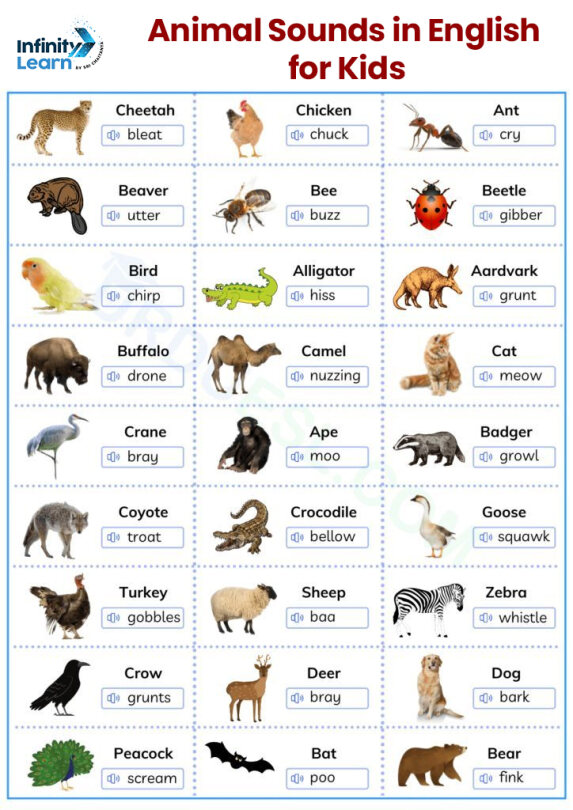Table of Contents
Animal sounds are not just noises; they are a delightful way for kids to connect with the animal kingdom. These sounds often bring smiles to their faces and spark their curiosity about the world around them. In this blog, we’ll dive into the world of animal sounds, discover which animals sounds which make, and learn 17 entertaining animal sounds in English that will surely captivate your kids.
Whether you are looking for information about animal sounds list, animals sounds and birds, animals with their sounds, animal sounds in English, cow sound name in English, bear sound name, dog sound name, sheep sound name, what the sound of monkey is called, bleat sound animal, or bee sound name, we have got you. This article covers animal sounds and how you can make sentences with these animal sounds.

What Are Animal Sounds?
Animal sounds are vocalizations or noises made by animals sounds as a means of communication, expression, or interaction with their environment. These sounds play a vital role in the animal kingdom, helping animals convey various messages, such as warning of danger, attracting mates, establishing territory, and expressing emotions like fear, aggression, or contentment.
Animal sounds can take many forms, including vocalizations, calls, cries, roars, barks, and chirps, among others. Each species of animal has its unique set of sounds, which can vary in pitch, volume, and complexity. These sounds are essential for the survival and behavior of the animal, helping them navigate their world and interact with other members of their species.
In addition to their functional purposes, animal sounds often intrigue humans, sparking curiosity and fascination, especially among children. Learning about animal sounds can be both entertaining and educational, as it offers insights into the rich and diverse world of creatures with whom we share our planet.

Animals and Their Sounds
Let’s explore some animals and the sounds they make:
- Dog (Canine):
- Sound: Bark
- Dogs communicate through various barks, from playful yips to protective barks.
- Cat (Feline):
- Sound: Meow
- Cats meow for different reasons, such as seeking attention or expressing hunger.
- Cow (Bovine):
- Sound: Moo
- Cows moo to communicate with their herd and to express various emotions.
- Horse (Equine):
- Sound: Neigh
- Horses neigh to communicate with other horses and express excitement or distress.
- Lion (Big Cat):
- Sound: Roar
- The lion’s roar is a powerful call used for territorial assertion and communication.
- Elephant:
- Sound: Trumpet
- Elephants trumpet to signal danger, excitement, or to communicate within their group.
- Duck (Waterfowl):
- Sound: Quack
- Ducks quack as a form of communication, often heard in ponds and lakes.
- Chicken (Poultry):
- Sound: Cluck
- Chickens cluck to communicate with each other, especially when they find food.
- Pig (Swine):
- Sound: Oink
- Pigs oink to communicate with other pigs and to express contentment or hunger.
- Monkey (Primate):
- Sound: Chatter or screech
- Monkeys make a variety of sounds to communicate within their social groups.
- Sheep (Ovine):
- Sound: Baa
- Sheep bleat to communicate with each other and often when seeking attention.
- Frog (Amphibian):
- Sound: Croak
- Frogs croak primarily during mating season to attract potential mates.
- Cricket (Insect):
- Sound: Chirp
- Male crickets chirp to attract females or establish territory.
- Dolphin (Marine Mammal):
- Sound: Click or whistle
- Dolphins use clicks for echolocation and whistles for communication.
- Whale (Marine Mammal):
- Sound: Sing
- Whales are known for their haunting and melodious songs, often used for communication and navigation.
- Owl (Bird of Prey):
- Sound: Hoot
- Owls hoot, especially during the night, to communicate with other owls.
- Squirrel (Rodent):
- Sound: Chitter
- Squirrels chitter or chatter when they sense danger or excitement.
Animal Sounds List in English
Here is a list of some common animals and the sounds they are often associated with:
- Dog: Bark
- Cat: Meow
- Cow: Moo
- Horse: Neigh
- Lion: Roar
- Elephant: Trumpet
- Duck: Quack
- Chicken: Cluck
- Pig: Oink
- Monkey: Chatter or screech
- Sheep: Baa
- Frog: Croak
- Crickets: Chirp
- Dolphin: Click or whistle
- Whale: Sing
- Owl: Hoot
- Squirrel: Chitter
- Goat: Bleat
- Tiger: Growl
- Gorilla: Grunt
- Bear: Growl or roar
- Rabbit: Squeak or purr
- Kangaroo: Grunt or click
- Coyote: Howl
- Hippopotamus: Grunt or roar
- Zebra: Whinny
- Peacock: Scream or call
- Parrot: Squawk or talk
- Seagull: Squawk
- Penguin: Bray or trumpeting
- Elephant Seal: Roar or growl
- Toucan: Croak or call
- Hyena: Laugh or cackle
- Cheetah: Chirp or growl
- Dolphin: Click or whistle
- Seal: Bark or growl
- Pelican: Squawk or grunt
- Giraffe: Bellow or bleat
- Panda: Bleat or chirp
- Bald Eagle: Screech
- Bee: Buzz
- Cricket: Chirp
- Penguin: Hoot or trumpeting
- Koala: Growl or bellow
- Turkey: Gobble
- Raccoon: Chatter or purr
- Peacock: Call or scream
- Coyote: Howl
- Hawk: Screech
- Hedgehog: Snuffle
These animal sounds can be a source of amusement and learning for kids, helping them develop their language skills and understanding of the natural world. Encourage your little ones to mimic these sounds and watch their faces light up with joy!
Make Sentences with the Sound of Animals in English
Here are sentences featuring the sounds of various animals:
- The dog woke us up early with its loud bark.
- I love it when my cat greets me with a gentle meow.
- The serene countryside was filled with the distant moo of grazing cows.
- As we approached the farm, we heard the cheerful neigh of a friendly horse.
- In the wilderness, the powerful roar of a lion echoed through the night.
- At the zoo, we marveled at the majestic elephant‘s trumpet.
- The pond came alive with the playful quack of ducks.
- The chicken in the backyard never stops clucking.
- The children giggled as they imitated the pig‘s oink.
- High in the trees, the monkey‘s chatter echoed through the jungle.
- As we strolled through the meadow, we heard the gentle baa of grazing sheep.
- The marshy area was filled with the enchanting croak of frogs.
- On a warm summer night, the rhythmic chirp of crickets filled the air.
- During our boat tour, we were delighted by the playful clicks and whistles of dolphins.
- While sailing, we were lucky to witness the majestic whale‘s enchanting song.
- In the moonlight, the owl began to hoot, creating an eerie yet calming atmosphere.
- The bustling park was filled with the joyful chitter of squirrels as they scampered about.
Animals That Produce No Sound
While many animals are known for their vocalizations and sounds, there are also numerous animals that produce little to no sound, at least in terms of vocal communication. These animals may rely on other means of communication, such as body language, visual signals, or chemical signals. Here are some examples of animals that are generally quiet:
- Snakes: Most snakes are silent creatures and do not produce vocal sounds. They rely on body language and pheromones for communication.
- Turtles: Turtles are known for their peaceful and silent demeanor. They do not vocalize but may hiss when threatened.
- Insects: The majority of insects communicate through visual cues, pheromones, or vibrations rather than vocal sounds. For example, ants use chemical signals to communicate with each other.
- Frogs and Toads: While some frog and toad species are known for their loud croaks, not all species vocalize. Many are silent or produce very soft sounds.
- Lizards: Lizards are generally quiet animals. They may use body language and gestures for communication.
- Fish: Fish do not produce vocal sounds but may communicate through visual cues and body language. Some fish species use electrical signals.
- Marine Mammals: While marine mammals like dolphins and whales are known for their vocalizations, not all marine species are noisy. Manatees, for example, are relatively quiet.
- Arachnids: Spiders and scorpions are typically silent creatures and rely on other forms of communication, such as vibrations in their webs or chemical signals.
- Jellyfish: Jellyfish are silent and do not produce vocal sounds. They primarily use tentacle movements for hunting and navigation.
- Starfish: Starfish are quiet marine creatures that do not produce vocal sounds. They move using tube feet and communicate through touch and chemical signals.
| Discover More About English Vocabulary | |
| 3 Letter Words | English Vocabulary Words |
| Action Words | Opposite Words |
| Rhyming Words | Compound Words |
| Action Words | Daily Used English Words |
| New Words In English | 6 Letter Words |
| Positive Words in English | How To Learn English Quickly |
| Difficult Words | 4 Letter Words |
| Praising Words | 7 Letter Words |
| Idioms in English | English Poems for Kids |
| Describing Words | Poems on Republic day |
Conclusion
Animal sounds provide a delightful gateway for kids to explore the animal kingdom and enhance their language development. Learning these sounds can be both entertaining and educational, fostering a deeper connection with the fascinating world of animals. So, have some fun with your kids as you discover the exciting sounds of the animal kingdom together.
Animal Sounds in English – FAQ’s
What is the names of animal sounds?
Animal sounds are known as vocalizations or calls, representing the noises animals make to communicate.
What is the animal sound in English for a cow?
The sound that a cow makes in English is typically described as moo.
What is the sound of a sheep called in English?
The sound of a sheep in English is commonly referred to as bleat.
What words are associated with animal sound?
Words associated with animal sounds include roar for lions, meow for cats, bark for dogs, neigh for horses, and quack for ducks, among others.








